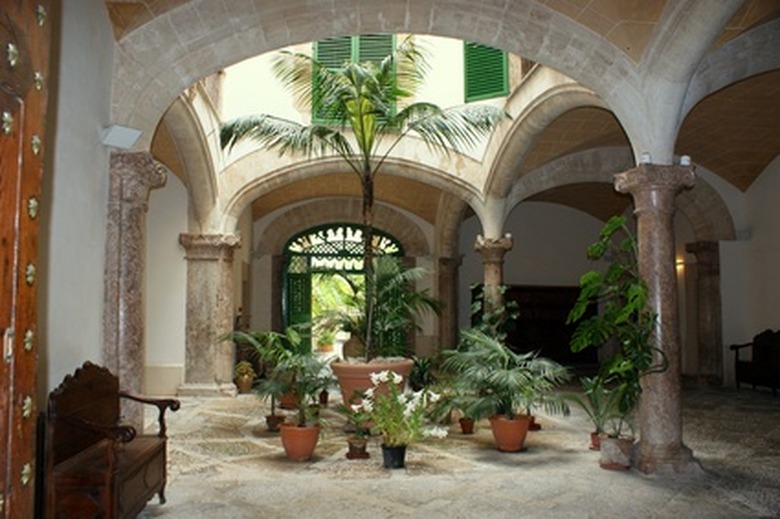Planter Boxes For Trees
Planter boxes or tubs are large-scale containers used to grow and display trees in places no soil exists, such as in a plaza or paved urban courtyard. Not only is a specimen tree grown, but groundcover plants like creeping juniper, ivy or lilyturf fill the box to mask the soil. The planter box must contain enough soil and be placed where the specific tree species receives the right amount of light to prosper. Choose plants that tolerate the wind and winter cold in at least one U.S. Department of Agriculture (USDA) hardiness zone colder than your location. For example, if you are in USDA zone 7, choose a tree known to survive a zone 6 winter; do not plant a zone 8 plant.
Types
Planter box materials have two things in common: durability and strength. Heavy-duty wood planks, thick vinyl or polyurethane or even a concrete-poured form all are used to construct large planter boxes to grow and display trees. The variety of materials allows designers to match aesthetics to the site as well as box surface textures and colors. Sizes also vary, but since trees are large plants, the bigger and more soil the planter box contains, the better.
- Planter boxes or tubs are large-scale containers used to grow and display trees in places no soil exists, such as in a plaza or paved urban courtyard.
Function
Planter boxes give gardeners flexibility in the types or location of trees grown in a landscape. If concrete or asphalt covers the soil, a planter box placed anywhere brings vegetation to the hardscape area while providing shade, screening or seasonal interest. Moreover, if a soil is infertile, contaminated or compacted so that in-ground planting of a tree isn't practical, the planter box is placed on site to provide ornamental beauty.
Features
Donna Fare and Wayne Clatterbuck write for the University of Tennessee Extension that planter boxes must have key features for successful growing of trees in them. First, the box bottom must have drainage holes to allow rain and irrigation water to escape and not smother roots. Secondly, the size of the box must contain ample soil and growing space for the tree, otherwise the tree will not live long. A minimum 4 foot by 4 foot square size is needed with a depth of 4 feet. Another guide for box size is that 2 feet of side wall width is needed for every 1 inch of trunk diameter of the tree type destined to be planted. Thus, a 3-inch wide tree trunk needs to be in at least a 6 foot by 6 foot box. Smaller boxes may work temporarily until roots become compacted.
- Planter boxes give gardeners flexibility in the types or location of trees grown in a landscape.
- If concrete or asphalt covers the soil, a planter box placed anywhere brings vegetation to the hardscape area while providing shade, screening or seasonal interest.
Considerations
Since tree roots in planter boxes are not protected by and in contact with the greater ground soil matrix, more watering and fertilizer is required. Both winter cold and summer hot temperatures penetrate into the root ball of the tree, affecting plant health needs, especially for water. University of Tennessee Extension recommends a well-drained, porous potting soil medium. It can include crumbly topsoil, but also must contain organic matter to prevent the medium from compacting. Dr. Peter May of Metro Trees mentions that street trees in planter boxes should be grown in a mix comprising the native soil at the site. Frequent, light liquid-based fertilization of the box's soil provides nutrients to roots that are naturally leached away with increased and repeated watering.
Plant Selection
The amount of soil and growing space afforded to trees in planter boxes is finite. Not all tree species cope well with the environmental conditions in a planter box, especially for years on end. Generally speaking, select tree species that are drought and cold tolerant in your region, as well as those that are slow-growing and do not grow into massive sizes. Trees with aggressive roots are a poor choice, as are fast-growing species since they will outgrow their box space quickly. The University of Tennessee provides some tree choices: small Japanese maples, slow-growing magnolias, small-sized ornamental cherries or dwarf conifers.
- Since tree roots in planter boxes are not protected by and in contact with the greater ground soil matrix, more watering and fertilizer is required.
- Not all tree species cope well with the environmental conditions in a planter box, especially for years on end.
Warning
Keep in mind a planter box filled with soil and tree is extremely heavy. Take extra time to place the box in the appropriate (and permanent) spot so the use of heavy machinery is not frequently needed across the year. If seasonal tree changes are scheduled, make sure the planter box materials are durable and strong enough to handle the frequent moving and change in temperatures without harm. Also remember that a tree will topple in wind if the planter box doesn't provide enough weighted anchorage.
